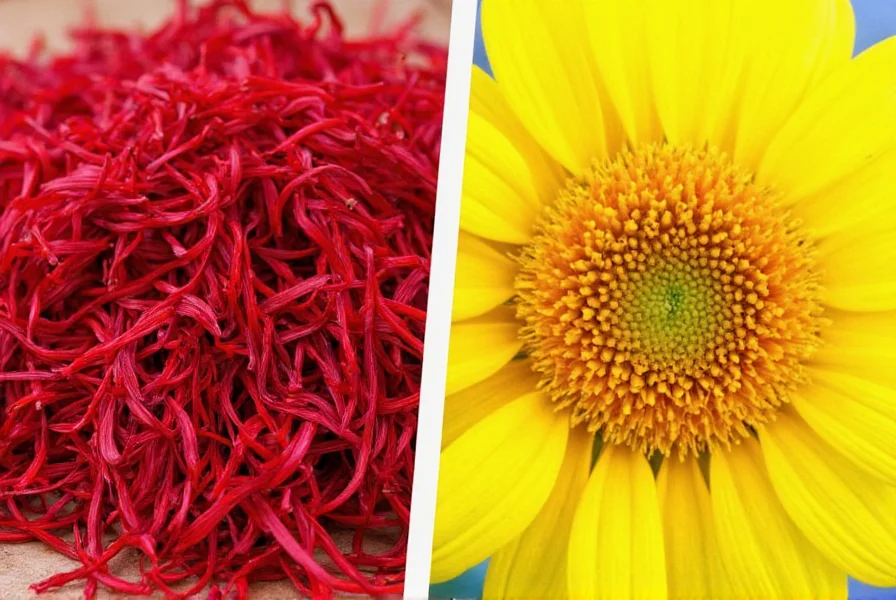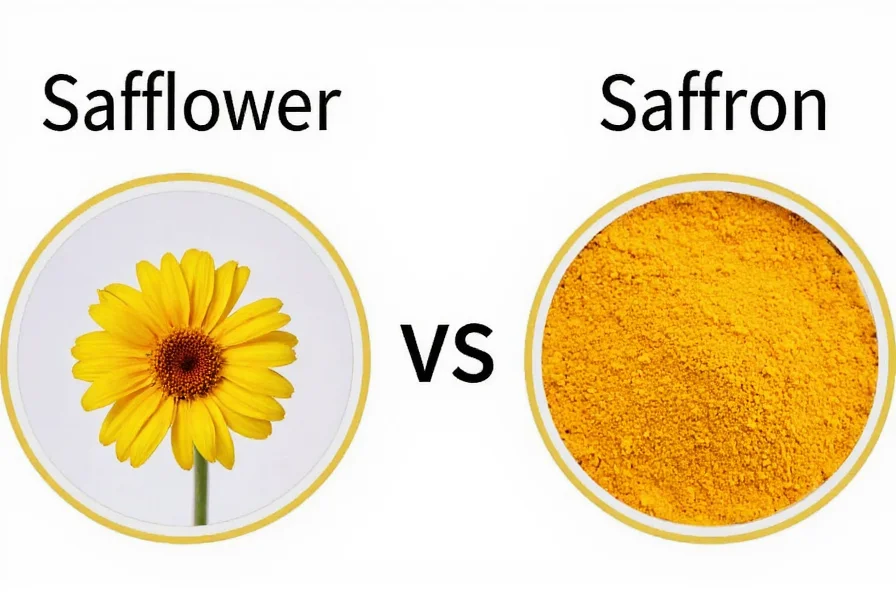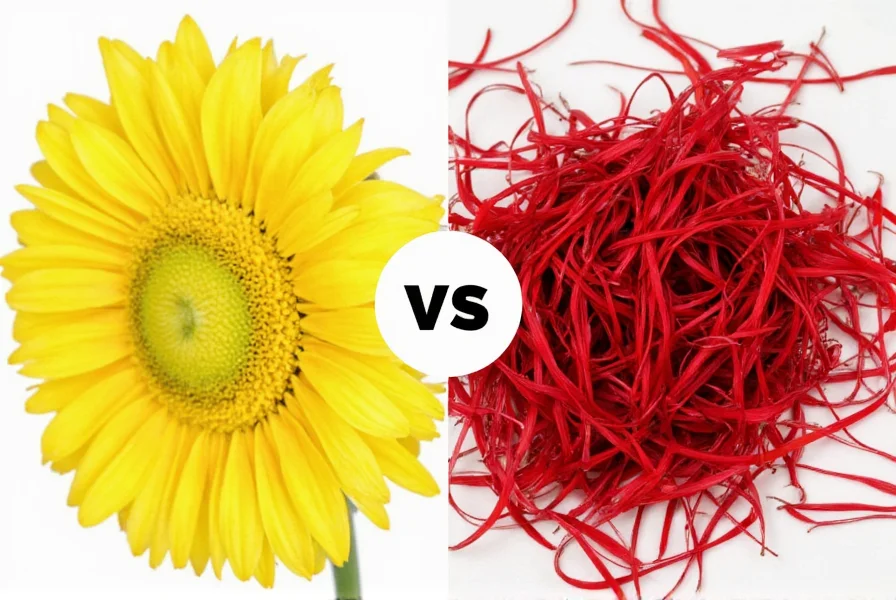Saffron and safflower confusion is common in kitchens worldwide, yet understanding the difference between safflower and saffron is crucial for both culinary success and avoiding potential fraud. This comprehensive guide examines their botanical origins, economic value, culinary applications, and health properties to help you make informed decisions when selecting these golden-hued ingredients.
Botanical Origins and Historical Context
Saffron comes exclusively from the Crocus sativus flower, a sterile triploid that must be propagated manually. Each purple crocus bloom produces just three red stigmas, which are hand-harvested at dawn when the flowers are still closed. This labor-intensive process explains why saffron remains the world's most expensive spice by weight.
In contrast, safflower (Carthamus tinctorius) is a thistle-like plant with yellow or red flowers. Its petals have been used since ancient Egyptian times as a textile dye and food coloring. While both plants produce vibrant hues, their saffron vs safflower chemical composition differs significantly—saffron contains crocin and picrocrocin (responsible for color and flavor), while safflower contains carthamin.
Physical Characteristics Comparison
| Characteristic | Saffron | Safflower |
|---|---|---|
| Source | Stigmas of Crocus sativus | Petals of Carthamus tinctorius |
| Color | Bright red threads with orange tips | Deep orange-red petals |
| Aroma | Distinctive honey-like, earthy fragrance | Mild, slightly grassy scent |
| Taste | Complex floral notes with slight bitterness | Neutral to slightly bitter |
| Color Release | Gradual golden hue in liquids | Immediate, intense red-orange color |
When examining these spices side by side, the how to tell real saffron from safflower question becomes clearer. Authentic saffron threads maintain their structure when soaked, releasing color slowly while retaining thread integrity. Safflower petals disintegrate quickly in liquid, creating an unnaturally vibrant red color without saffron's characteristic aroma.

Economic Value and Market Realities
The safflower vs saffron price comparison reveals why substitution attempts occur. Genuine saffron costs between $5,000-$10,000 per kilogram, requiring approximately 150,000 hand-picked stigmas to produce one kilogram. Safflower sells for less than 1% of saffron's price, making it a frequent target for fraudulent substitution.
Unfortunately, saffron fraud prevention remains challenging. Unscrupulous sellers sometimes dye safflower petals with turmeric or other colorants to mimic saffron's appearance. Consumers should purchase saffron from reputable sources that provide origin documentation and avoid products with suspiciously low prices or unnaturally uniform coloring.
Culinary Applications and Substitution Realities
While both spices provide color, their saffron vs safflower flavor profiles differ dramatically. Saffron contributes a complex flavor essential to dishes like Spanish paella, Italian risotto alla Milanese, and Persian tahdig. Safflower primarily offers color without saffron's distinctive taste.
When considering can safflower substitute for saffron, the answer depends on your culinary goal:
- For color only: Safflower works in some applications like coloring rice or bread
- For authentic flavor: No suitable substitute exists for genuine saffron
- Better alternatives: A pinch of turmeric with a few saffron threads provides acceptable color with some authentic flavor
Chefs specializing in Mediterranean and Middle Eastern cuisines emphasize that saffron's unique chemical composition cannot be replicated. The compound picrocrocin creates saffron's characteristic flavor, while safflower lacks this component entirely.
Health Properties and Nutritional Profiles
Research into saffron vs safflower health benefits shows both have potential therapeutic properties, but through different mechanisms:
- Saffron: Contains crocin (antioxidant), safranal (neuroprotective), and picrocrocin. Studies suggest benefits for mood regulation, eye health, and PMS symptoms.
- Safflower: Rich in lutein and zeaxanthin (eye health), with potential cardiovascular benefits from its linoleic acid content.
While both offer antioxidant properties, saffron's research-backed cognitive benefits distinguish it from safflower. However, safflower oil (from the plant's seeds) has different nutritional properties than the petal-based coloring agent.

Practical Identification Guide
To avoid purchasing adulterated products, use these verification methods for identifying authentic saffron:
- Water test: Place threads in warm water—authentic saffron releases color gradually over 15-20 minutes while maintaining thread structure
- Paper test: Place threads on blotting paper—real saffron leaves a yellow halo without immediate red bleeding
- Smell test: Genuine saffron has a distinctive honey-like aroma, not purely medicinal or grassy
- Taste test: Authentic saffron has complex flavor notes, not just bitter
Be wary of products labeled “Spanish saffron” that cost less than $10 per gram—this typically indicates safflower or other substitutes. Premium Iranian or Kashmiri saffron commands higher prices due to superior quality and labor-intensive harvesting.
Conclusion: Making Informed Choices
Understanding the safflower vs saffron differences empowers consumers to make educated decisions. While safflower serves as an economical coloring agent in some applications, it cannot replicate saffron's unique flavor profile. For dishes where saffron is integral to the recipe's identity, no substitute provides equivalent results.
When purchasing saffron, prioritize quality over price and verify authenticity through simple tests. For color-only applications where flavor isn't critical, safflower presents a cost-effective alternative. Recognizing these distinctions preserves culinary integrity while preventing unintentional fraud in your kitchen.
What's the main difference between safflower and saffron?
Saffron comes from the stigmas of the Crocus sativus flower and provides both distinctive flavor and color, while safflower comes from a different plant (Carthamus tinctorius) and primarily offers color without saffron's characteristic taste. Saffron contains unique compounds like crocin and picrocrocin that safflower lacks.
Can I substitute safflower for saffron in recipes?
Safflower can substitute for saffron only when you need color but not authentic flavor. For dishes where saffron's distinctive taste is essential (like paella or bouillabaisse), safflower won't provide the same culinary experience. A better approach is using a small amount of real saffron combined with turmeric for color.
Why is saffron so much more expensive than safflower?
Saffron's high cost comes from its labor-intensive harvesting process—each crocus flower produces only three stigmas that must be hand-picked at dawn. It takes approximately 150,000 flowers to produce one kilogram of saffron. Safflower petals are much easier to harvest mechanically, making them significantly more affordable.
How can I tell if my saffron is real or adulterated with safflower?
Perform a water test: place threads in warm water. Authentic saffron releases color gradually over 15-20 minutes while maintaining thread structure. Safflower disintegrates quickly, creating an immediate intense red color. Real saffron also has a distinctive honey-like aroma and complex flavor, not just bitterness.
Do safflower and saffron have similar health benefits?
Both offer antioxidant properties but through different compounds. Saffron contains crocin and safranal, with research supporting benefits for mood regulation and eye health. Safflower provides lutein and zeaxanthin, beneficial for vision, and its oil contains linoleic acid that may support cardiovascular health. Saffron has more research backing its cognitive benefits compared to safflower.











 浙公网安备
33010002000092号
浙公网安备
33010002000092号 浙B2-20120091-4
浙B2-20120091-4